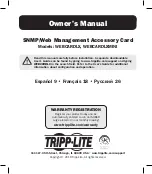
AT-GS950/16PS Switch Web Interface User’s Guide
153
VLAN Index
You must assign a unique number to each tagged VLAN in a network. This
number is called the tagged VLAN ID. This number uniquely identifies a
tagged VLAN in the AT-GS950/16PS switch and across the network.
VLAN Name
To create a tagged VLAN, you must give it a unique name. This name can
reflect the function of the network devices that are VLAN members, such
as Sales, Production, and Engineering.
Tagged and Untagged Ports
When you specify that a port is a member of a tagged VLAN, you need to
specify that it is tagged or untagged. By definition, the port is a static
member of a tagged VLAN when it is configured as either a tagged or
untagged port. You can have a combination of tagged and untagged ports
in the same VLAN.
Note
A port can also be dynamically assigned to a tagged VLAN within a
voice VLAN configuration which is a special configuration of a
tagged VLAN. For more information concerning static and dynamic
membership in a tagged VLAN, see the Overview section for “Voice
VLAN” on page 257.
Packet transmission from a tagged port differs from packet transmission
from an untagged port. When a packet is transmitted from a tagged port,
the tagged information within the packet is maintained when it is
transmitted to the next network device. If the packet is transmitted from an
untagged port, the VLAN tag information is removed from the packet
before it is transmitted to the next network device.
The IEEE 802.1Q standard describes how tagging information within a
packet is used to forward or discard traffic throughout the switch. If the
incoming packet has a VLAN tag that matches one of the Group IDs of
which the port is a member, the packet is accepted and forwarded to the
appropriate port(s) within that VLAN. If the incoming packet’s VLAN tag
does not match one of the Group IDs assigned to the port, the packet is
discarded.
Port VLAN Identifier (PVID)
When an untagged packet is received on a port in a tagged VLAN, it is
assigned to one of the VLANs of which that port is a member. The
deciding factor in this process is the Port VLAN Identifier (PVID). Both
tagged and untagged ports in a tagged VLAN must have a PVID assigned
to them. The default value of the PVID for each port is 1. The switch
Содержание AT-GS950/16PS
Страница 12: ...Figures 12...
Страница 14: ...List of Tables 14...
Страница 18: ...Preface 18...
Страница 20: ...20...
Страница 52: ...Chapter 2 System Configuration 52...
Страница 54: ...54...
Страница 92: ...Chapter 5 Multiple Spanning Tree Protocol 92...
Страница 102: ...Chapter 6 Static Port Trunking 102...
Страница 118: ...Chapter 8 Port Mirroring 118...
Страница 140: ...Chapter 11 IGMP Snooping 140...
Страница 174: ...Chapter 14 GVRP 174...
Страница 186: ...Chapter 15 Quality of Service and Cost of Service 186...
Страница 188: ...188...
Страница 216: ...Chapter 17 SNMPv3 216...
Страница 244: ...Chapter 18 Access Control Configuration 244...
Страница 282: ...Chapter 21 Security 282...
Страница 288: ...Chapter 22 Power Over Ethernet PoE 288...
Страница 289: ...289 Chapter 23...
Страница 310: ...Chapter 24 LLDP 310...
Страница 322: ...322...
Страница 334: ...Chapter 26 Software Configuration Updates 334...
Страница 346: ...Chapter 28 Rebooting the AT GS950 16PS 346...
Страница 368: ...Appendix A MSTP Overview 368...
Страница 386: ...Appendix B AT GS950 16PS Default Parameters 386...
















































